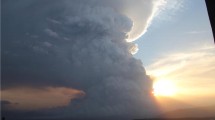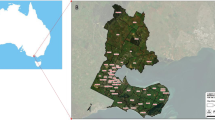Abstract
This paper summarizes the fuel type systems currently adopted by the fire danger rating systems or fire behavior prediction systems of some countries, such as Canada, the United States, Australia, Greece, and Switzerland. As an example, the Canadian Forest Fire Danger Rating System organizes fuel types into five major groups, with a total of 16 discrete fuel types recognized. In the United States National Fire Danger Rating System, fuel models are divided into four vegetation groups and twenty fire behavior fuel models. The Promethus System (Greece) divides fuels into 7 types, and Australia has adopted only three distinct fuel types: open grasslands, dry eucalyptus forests, and heath/shrublands. Four approaches to mapping fuels are acceptable: field reconnaissance, direct mapping methods, indirect mapping methods, and gradient modeling. Satellite remote-sensing techniques provide an alternative source of obtaining fuel data quickly, since they provide comprehensive spatial coverage and enough temporal resolution to update fuel maps in a more efficient and timely manner than traditional aerial photography or fieldwork. Satellite sensors can also provide digital information that can be easily tied into other spatial databases using Geographic Information System (GIS) analysis, which can be used as input in fire behavior and growth models. Various fuel-mapping methods from satellite remote sensing are discussed in the paper. According to the analysis of the fuel mapping techniques worldwide, this paper suggests that China should first create appropriate fuel types for its fire agencies before embarking on developing a national fire danger rating system to improve the current data situation for it's fire management programs.
Similar content being viewed by others
References
Agee, J.K. and Pickford, S.G. 1985. Vegetation and Fuel mapping of North Cascades national Park Service Complex [R]. National Park Serv., Cooperative Park Studies Unit, Univ Washington, Seattle, WA.
Anderson, H.E. 1982. Aids to determining fuel models for estimating fire behavior [R]. USDA For. Serv., National Wildfire Coordinating Group, Gen. Tech. Rep. INT-122.
Andrews, P.L. 1986. BEHAVE: fire behavior prediction and fuel modeling system [R]. Burn subsystem. Part 1. USDA For. Serv., Gen. Tech. Rep. INT-194.
Brown, J.K., 1982. Fuel and fire behavior prediction in big sagebrush [R]. USDA For. Ser., Res. Pap. INT-290.
Byram, G.M. 1959. Compubstion of forest fuels [C]. In: K.P. Davis (ed.), Forest Fire: Control and Use. New York: McGraw-Hill, 61–89.
Canadian Forestry Service. 1987. Tables for the Canadian Forest Fire Weather Index System [R]. Can. For. Serv., For. Tech. Rep. No. 25 (4th edition). Ottawa, ON.
Canadian Interagency Forest Fire Centre. 2002. The 2002 glossary of forest fire management terms. Available at: http://wlapwww.gov.bc.ca/esd/fire_mgmt_gloss_2002.pdf.
Castro, R. and Chuvieco, E. 1998. Modeling forest fire danger from geographic information systems [J]. Geocarto Int.,13: 15–23.
Cheney P. 1992. A National Fire Danger Rating System for Australia. International Forest Fire News, (No. 6-January 1992) [OL]. Available at: http://www.fire.uni-freiburg.de/iffn/country/au/au_4.htm.
De Wulf, R.R., Goossens, R.E., Roover, B.P., and Borry, F.C. 1990. Extraction of forest stand parameters from panchromatic and multispectral SPOT-1 data [J]. Int. J. Remote Sens.,11: 1571–1588.
Deeming, J.E., Burgan, R.E., and Cohen J.D. 1978. The national fire-danger rating system-1978[R]. USDA For. Serv., Gen. Tech. Rep. INT-39.
Dymond C.C., Roswintiarti, O. and Brady, M. 2004. Characterizing and mapping fuels for Malaysia and western Indonesia [J]. Internat. J. of Wildl. Fire,13: 323–334.
Food and Agriculture Organization of the United Nations. 1986. Wildland Fire management terminology [R]. For. Pap. M-99.
Finney, M.A. 1995. FARSITE—A Fire Area Simulator for Mangers [C]. In: The Biswell Symposium: Fire Issues and Solutions in Urban Interface and Wildland Ecosystems [R]. USDA For. Serv., Gen. Tech. Rep. PSW-158.
Finney, M.A. 1998. FARSITE: Fire Area Simulator-model development and evaluation [R]. USDA For. Serv., Res. Pap. RMRS-RP-4.
Forestry Canada Fire Danger Group, 1992. Development and structure of the Canadian Forest Fire Behavior Prediction System [R]. For. Can., Ottawa, On. Inf. Rep. ST-X-3.
Giakoumakis, M. N., Gitas, I.Z., and San-Miguel J. 2002. Object-oriented classification modeling for fuel type mapping in the Mediterranean, using LANDSAT TM and IKONOS imagery preliminary results. In: Viegas (Ed.) Forest Fire Research & Wildland Fire Safety. Millpress, Rotterdam, 1–13
Harvey, S., Rüegsegger, M., and Allgöwer, B. 1997. Fuel Models for Switzerland (Swiss National Park) [OL]. Available at: http://www.geo.unizh.ch/gis/research/edmg/fire/papers/minerve/fuel.pdf
Jensen, J.R., Beaty, K.A., Byron, J.R., Huang, X., Jackson, M.W., Yang X. 1986. Introductory Digital Image Processing: A Remote Sensing Perspective [M]. 2nd edition., NJ(USA): Prentice Hall PTR, Upper Saddle River, p384
Keane, R.E., Burgan, R., and Wagtendonk, J.V. 2001. Mapping wildland fuels for fire management across multiple scales: Integrating remote sensing, GIS, and biophysical modeling [J]. Internat. J. Wildl. Fire10: 301–319.
Kwasny, J.L. 2000. Mapping vegetation in green swamp preserve for fuel modeling using remote sensing techniques [D]. Great Britain: Nicholas School of the Environment of Duke Univ., Master's Thesis.
Loveland, T.R. 2001. Toward a national fuels ampping strategy: Lessons from selected mapping programs [J]. Internat. J. Wildl. Fire10: 289–299.
National Wildfire Coordinating Group. 1996. Glossary of Wildland Fire Terminology. National Interagency Fire Center, USA [OL]. Available at:http://www.nwcg.gov/teams/pmo/products/wfglossary/content.htm
Oswald, B.P., Fancher, J.T., Kulhavy, D.L., and Reeves, H.C. 1999. Classifying fuels with aerial photography in East Texas [J]. Internat. J. Wildl. Fire,9: 109–113.
Riaño, D., Chuvieco, E., Salas, J., Orueta, A.P., and Bastarrika, A. 2002. Generation of fuel type maps from Landsat TM images and ancillary data in Mediterranean ecosystems [J]. Can. J. For. Res.,32: 1301–1315.
Roberts, D.A., Green, R.O., and Adams, J.B. 1997. Temporal and spatial patterns in vegetation and atmospheric properties from AVIRIS [J]. Remote Sens. Environ.,62: 223–240.
Root, R.R. and van Wagtendonk J.W. 1999. Hyperspectral analysis of multi-temporal Landsat TM data for mapping fuels in Yosemite National Park [C]. In: Porthland: Annual Conf. Amer. Soc. Photog. and Remote Sensing., OR. Available at: http://www.werc.usgs.gov/yosemite/posters/yosemite-posters.html
Rothermel, R.C. 1972. A mathematical model for predicting fire spread in wildland fuels [R]. USDA For. Serv., Gen. Tech. Rep. INT-115.
Sebastián-López A., S. Miguel-Ayanz J. Libertà G. 2000. An integrated forest fire risk index for Europe [OL]. Available at: http://natural-hazards.jrc.it/documents/fires/2000-presentations/earsel2000.pdf.
Sebastián-López, A. and San Miguel-Ayanz, J. 2002. Integration of satellite sensor data, fuel type maps and meteorological observations for evaluation of forest fire risk at the pan-European scale [J]. Int. J. Remote Sensing23: 2713–2719.
Trabaud, L. (ed.) 1999. Life and environment in the Mediterranean [M]. Southampton (Fance): WIT Press, p 400.
Van Wagtendonk, J.W. 1997. Use of thematic mapper imagery to map fuel models [C]., In: Proceedings of 13th Conference on Fire and Forest Meterology, Oct 27–31, 1996 in Lorne, AUSTRALIA, pp22–26.
Van Wagtendonk, J.W. and Root, R.R. 2000. Hyperspectral analysis of multi-temporal Landsat TM data for mapping fuels in Yosemite National Park [C]. In: Neuenschwander, L.F. and K.C. Ryan (Tech. Eds.), Proceedings of the Joint Fire Science Conference and Workshop., Vol. 1, Boise, ID, 15–17 June, p. 224–228.
Van Wagtendonk, J.W., Zhu, Z., and Lile E.L. 2004. Prefire risk assessment and fuels mapping [C]. In: Livingston, R.K. (Ed.) Third US Geological Survey Wildland Fire-Science Workshop., USGS Scientific Investigations Report 2004-5005, p 49–52
Zhu, Z. and Evans, D.L. 1994. US forest types and predicted percent forest cover from AVHRR data [J]. Photogramm. Eng. Remote Sens.,60: 525–531.
Author information
Authors and Affiliations
Additional information
Fundation item: This paper was supported by the Beijing Fund of Nature Science (No. 6042025), China NKBRSF Project (No. 2001CB409600) and Laboratory of Forest Protection, State Forestry Administration.
Biography: TIAN Xiao-rui (1971-), Corresponding author, male, Ph. Doctor, associate professor in Research Institute of Forestry Protection, Chinese Academy of Forestry, Beijing 100091, P.R. China.
Responsible editor: Chai Ruihai
Rights and permissions
About this article
Cite this article
Xiao-rui, T., McRae, D.J., Li-fu, S. et al. Fuel classification and mapping from satellite imagines. Journal of Forestry Research 16, 311–316 (2005). https://doi.org/10.1007/BF02858198
Received:
Accepted:
Issue Date:
DOI: https://doi.org/10.1007/BF02858198




